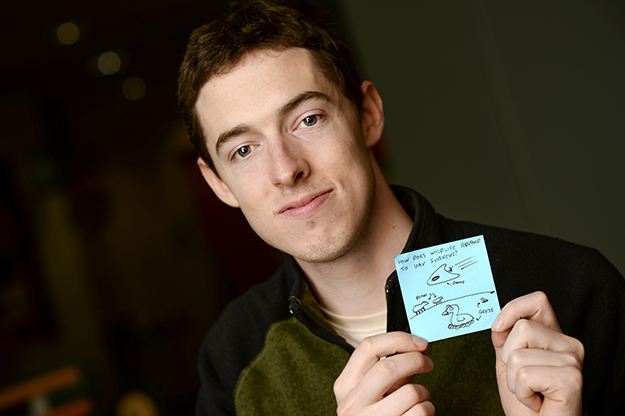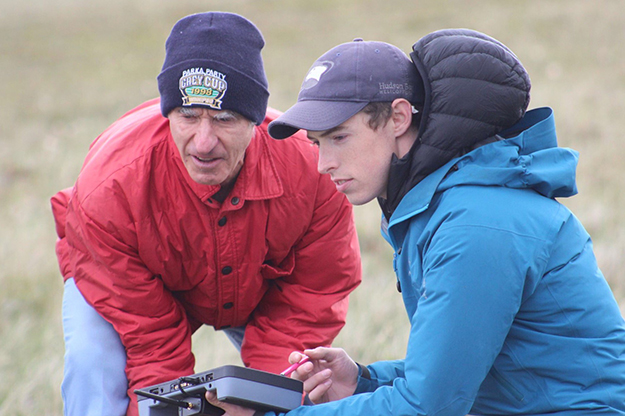Power of the ‘Post-it’
Art, science and communication collide as UND biology grad student’s Twitter hashtag trend goes viral

When UND Biology graduate student Andrew Barnas gets bored or frustrated, he reaches for a pen and paper.
“I doodle. I’m not sure if that qualifies me as an artist,” said the British Columbia native said, a small sticky note drawing resting on the notebook before him.
He may not be confident in his sketching abilities, but Barnas has recently learned a thing or two about the viral opportunities of social media. With one tweet of a research-based drawing and the hashtag #PostItNoteScience, he set off a trend within the global science community.
“It’s a little overwhelming,” Barnas laughed.
The idea of #PostItNoteScience was born out of exasperation. Barnas was reading a research paper for class when he came across a passage that was weighed down in wordy scientific jargon. He said this kind of complicated writing is common in his field.
“You’re just going to lose readers by making your writing really complicated,” Barnas said. “You should be able to take your idea and condense it down to its simplest form. And what’s simpler than a Post-it? Just put it on a Post-it note and work from there.”
So Barnas drew his own research on a three-by-three-inch square of paper—a drone flying over the Canadian habitat of snow geese and bears. He included the straightforward question: “How does wildlife respond to UAV surveys?” After snapping a photo and adding a couple of tags and hashtags, he let the tweet fly.
Some of Barnas’ colleagues found it to be a fun idea, and began to doodle and tweet their own research. Then, #PostItNoteScience exploded.
“First it was other people in wildlife, then the chemists and the physicists started putting their stuff out. It all happened so fast, and the rate at which it spread was just incredible,” Barnas said.
Within a few days, the hashtag had gone global, with scientists tweeting as far as South Africa, Australia, and much of Europe. A week after his initial tweet, at least 250 scientists had doodled and shared their research. Ibis—the International Journal of Avian Science—and the Royal Science Institute in London jumped in by retweeting their favorites.
Even Barnas’ graduate advisor, UND Assistant Professor of Biology Susan Felege, took a crack at her own research art.
“It forced scientists like me to think about what we do and how could we make it something anyone could understand,” Felege said. “In a day and age when science is so important to decisions we need to make—and with science seeing a lot of reduced funding—scientists sometimes struggle with communicating what we find to broader audiences, and even why it is important. Anything we can do to reach broader non-science audiences is going to be key.”

Communicating science
Effectively telling the story of science is a professional interest of Matthew Gilmore, associate professor of atmospheric sciences at UND. In 2015, UND’s Office of Instructional Development helped fund Gilmore’s participation in a one-week boot camp hosted by the Alan Alda Center for Communicating Science. The workshop used improvisation and storytelling exercises to force scientists to simplify their message without losing accuracy.
“What they told us is it’s not about dumbing it down, it’s about making it simpler and starting on the same level as your audience,” Gilmore said. “You’re trying to put yourself in their shoes and realize how you would feel if this wasn’t your area of expertise and you were seeing it for the first time.”
The experience shaped the development of an undergraduate class in Science Communication that Gilmore taught last spring. He said more and more universities across the country are offering science communication training in the form of classes, workshops or certificate programs.
“A lot of our grants that fund the research by UND students and faculty are paid with taxpayer dollars, so I think it’s our obligation to at least try to communicate the importance of our research,” he said.
Gilmore is collaborating with Associate Professor of English Chris Nelson to bring an event called Three Minute Thesis (3MT) to UND. The competition tasks graduate students with presenting their research in just three minutes using only one static visual aid. They are judged on how clearly and concisely they can explain their research in 180 seconds while capturing and maintaining the attention of the audience.
“It really forces you to get to the essence. As researchers, we love to get lost in the details,” Gilmore said. “If we treated #PostItNoteScience like an extreme version of the three-minute thesis—designed for 10 second consumption—you’d really better have your key message in there.”
Although Barnas knows his Twitter fame won’t last forever, he’s glad that #PostItNoteScience is starting a conversation—and making an impact.
“This hashtag is not important by itself. It’s a part of a bigger picture of scientists wanting to communicate their research and their stories,” Barnas said. “If you can just reach one or two people and help them learn something interesting, then that’s mission accomplished.”


